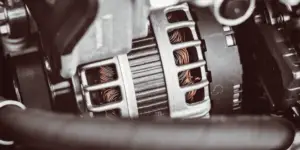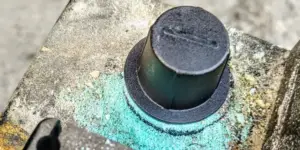A common reason for a badly charging battery is a defective alternator. It stands to reason that if the alternator is not producing enough charge, the battery will not be supplied with the charge it needs to start the car when required.
However, what if your car is being charged perfectly fine by the alternator only to lose its charge when the car is left stationary, sometimes overnight?
This can occur when you have a defective diode or multiple defective diodes in your alternator. If more than one diode is bad, you may have noticed a drop-off in the performance of your electrical systems when driving the car. The air con in summer or heated seats and demister in winter may be less effective than normal.
Often though, especially just when one diode is defective, you may be totally unaware that you have an issue until you have difficulty starting the car in the morning.
A diode is very much like a one-way valve. It allows the current to pass to the battery and should not allow it to return in the other direction.
When the diode is bad, a process called parasitic draw occurs. A parasite draws vital supplies away from its host. In this case, electrical charge. Like many parasites, you don’t know it’s there and what it’s doing until you notice the consequences of its actions.
As diodes age inside the alternator, they are prone to stick, which means the charge can go both ways to and from the alternator to the battery.
This is not what they are designed to do, and if left will eventually ruin your battery as the voltage drops below the level where it can be easily recharged.
If you’ve had to charge the battery overnight to get your car started in the morning, it is time to investigate the alternator diodes to ensure it is not taking charge away during the night.
The more times you allow your battery to go totally flat, the more difficult it will be to charge it’s going forward.
This could leave you with an expensive bill to replace or repair the alternator, and you may also have to spend money on a new battery.
A Simple Alternator Parasitic Draw Test
A bad diode will take a few hours to drain enough charge from the battery to stop the car from starting.
Try this.
After driving your car, return to it in about an hour and turn the key. If the car doesn’t start, it’s unlikely to be a parasitic draw.
Why?
A faulty diode would take longer to take charge away from the battery than this. A battery that can’t start the car after this short time is likely to be caused by another reason.
It could be that the battery is unable to take a charge, or it could be that the alternator is not charging the battery correctly. It is very unlikely to be a parasitic draw unless you have more than two diodes gone bad.
This basic test you can do without any tools, but it is not 100% accurate.
For this, you will need a multimeter. This is a great piece of kit that will save you a tonne of money throughout your car ownership. It can diagnose electrical issues without the need to take your car to a car shop.
Parasitic Draw Test Using A Multimeter
- This test is best performed when the battery is fully charged. A good time to do it would be in the morning after you have been charging the battery overnight, and you don’t have to go out and use the car early on. A partly discharged battery may not give an accurate result during this test.
- Next, you need to turn off all of the electrical systems in your car. Ensure that you’ve done this because if you have left the circuit open and believe that the circuit will close once the engine is turned off, you may be mistaken.
- Make sure that your headlights are off and not on the auto setting. Also, make sure you turn off the car stereo system.
- It’s worth noting that other defective electronic car parts can drain the battery when the car is switched off. Light relays in the fuse box are often the cause, but this is extremely gradual as the draw is quite small compared to what an alternator can draw from the battery.
- Leave all your car doors open and ensure the dome light is off. Waiting 30 minutes will ensure that any residual charge has been depleted, and you will get accurate results.
- After 30-minutes, return to your car with your multimeter. You want to see no more than 15 milliamps on these tests. That is acceptable and will not cause your battery to drain.
I could write the process down but sometimes, seeing things visually is better for understanding what’s happening.
Below, you will see a video on how to thoroughly check your electrical system for parasitic draws and the steps you need to go to eliminate all causes. This is the best one I could find, and I highly recommend it.
Will A Bad Alternator Diode Drain A New Battery?
Although a new battery may be sturdy than one subjected to a parasitic draw, it will still drain eventually.
It is a false economy to replace the battery and hope that the issue with the diode in the alternator goes away. It won’t.
Although batteries come with a one or 2-year guarantee, Battery manufacturers are not in the habit of replacing batteries without first investigating what is wrong with them. They will often test to see if the battery can hold a charge and investigate further if it can’t.
Most manufacturers will have clauses and terms within the warranty specifying that if an alternator was at fault and caused the battery to be rechargeable, they will not refund or replace the battery in those circumstances.
Far better to get the alternator diodes fixed than to purchase a new battery and still have to get an alternator later.
In summary
- A bad alternator diode will drain your car’s battery
- Your alternator has six diodes, and the more that are faulty will result in your battery draining quicker
- Buying a new battery will not fix the problem, and you will likely be in the same situation within a month.
- Always test the alternator and the battery before replacing one of these parts.
- Often the wrong part is replaced, leading to additional expense.












